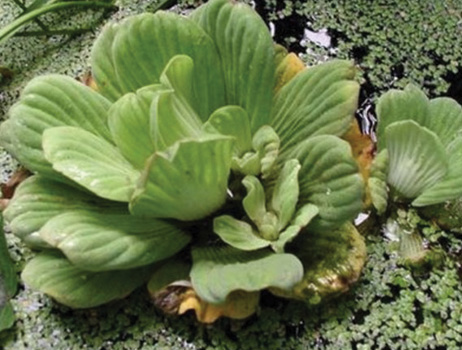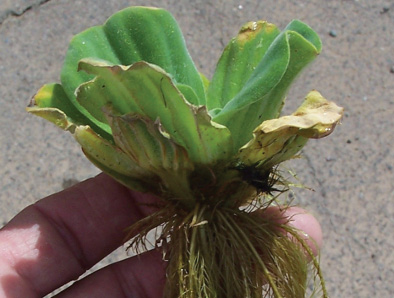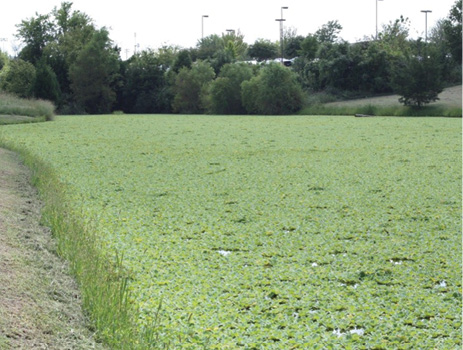Water Lettuce | Pistia stratiotes
Floating | Non-Native



Water lettuce is a highly invasive species that floats on the water’s surface. It is thought to have been introduced to Florida before 1765. Typically, it grows no more than 9 inches above the water, but it can completely cover a waterbody and prevent sunlight penetration.
This species resembles a floating head of lettuce, with leaves arranged in rosettes. It has very thick, hairy, light dull green leaves with parallel ridges and no leaf stalk. The roots are pale and feathery, and the root system can grow deeply into the waterbody. Flowers are tiny and inconspicuous.
The species can reproduce by seed but more commonly uses vegetative reproduction. Stolons (runners) extend horizontally and form new daughter plants. This mode of reproduction is rapid and quickly produces mats that obstruct both human and wildlife use.
Management Value
Water lettuce is extremely invasive and should never be introduced. It can quickly cover the water’s surface and eliminate nearly all light penetration. Eradicate on first sign.
Recommended Controls
Option 1: Flumioxazin (4-pound formulation). For each gallon of water, mix 0.1 ounce flumioxazin and 1.3 ounces non-ionic surfactant. Use a buffering agent when mixing with water with pH greater than 7.0. Spray to wet all plants. Do not exceed annual herbicide rate limits as stated on the product label.
Option 2: Diquat (3.73-pound formulation). For each gallon of water, mix 1.28 ounces diquat and 1.3 ounces non-ionic surfactant water. Spray to wet all plants. Do not exceed annual herbicide rate limits as stated on the product label.
When treating severe water lettuce infestations, treat one-third of the pond at a time, with at least 2 weeks between applications. After the entire pond has been treated, a repeat whole-pond application may be necessary to eliminate remaining plants.
Read and follow all chemical label instructions, especially the section on the use of personal protection equipment.
Photo Credits Top: Leslie J. Mehrhoff, University of Connecticut, Bugwood.org; Middle: Russell Engel, Arizona Game and Fish Department

The information given here is for educational purposes only. References to commercial products, trade names, or suppliers are made with the understanding that no endorsement is implied and that no discrimination against other products or suppliers is intended.
Publication 3735-46 (POD-11-23)
By Wes Neal, PhD, Extension/Research Professor, Wildlife, Fisheries, and Aquaculture; Dennis Riecke, Fisheries Coordinator, Mississippi Department of Wildlife, Fisheries, and Parks; and Gray Turnage, PhD, Assistant Research/Extension Professor, GeoSystems Research Institute.
The Mississippi State University Extension Service is working to ensure all web content is accessible to all users. If you need assistance accessing any of our content, please email the webteam or call 662-325-2262.



